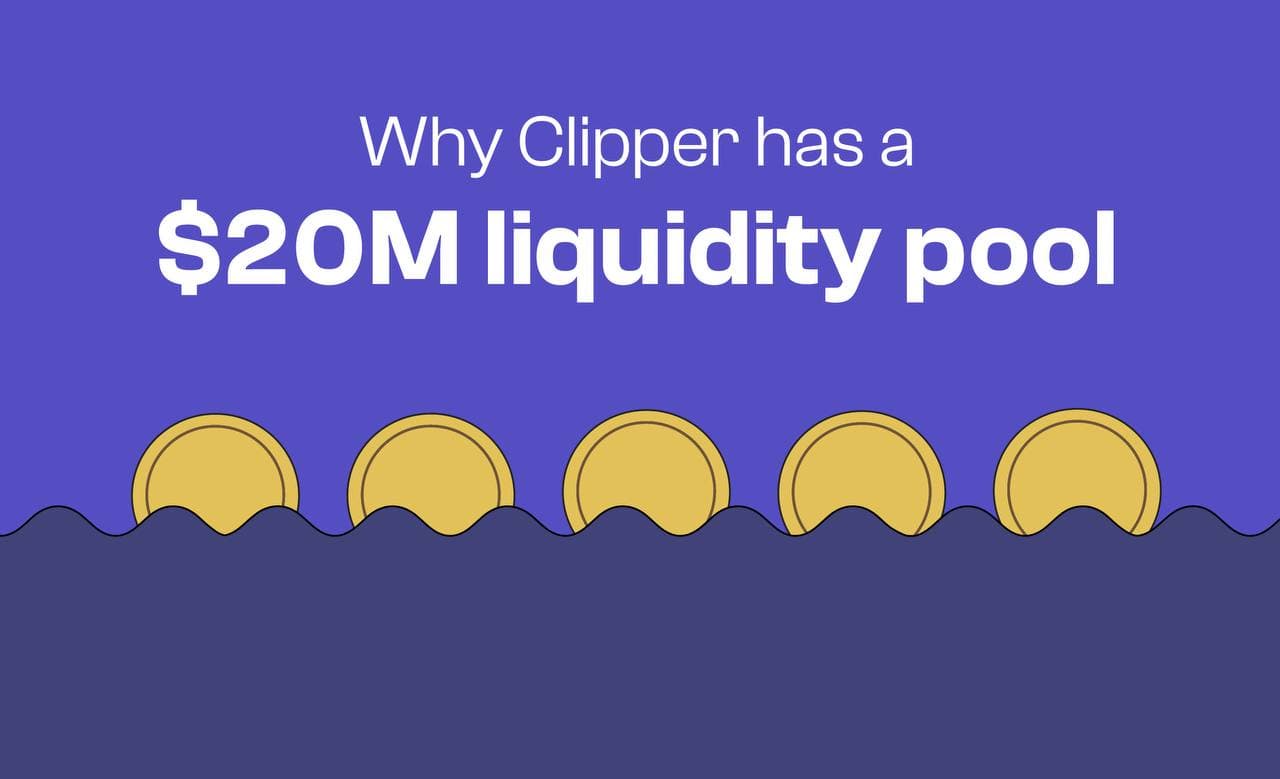Why Clipper’s Liquidity Pool is Capped at $20M

Note: In April 2022, Clipper's architecture was upgraded to a novel Formula Market Maker (FMM) model, which allows for lower gas costs, broader price optimization, and smoother liquidity deposits/withdrawals. As a result, Clipper's liquidity pool is no longer explicitly capped. This article will remain in place for the sake of transparency, but note that the most accurate and up-to-date explanation of how Clipper works can now be found here.
At Shipyard Software, we know that not all trades are the same, and that every user has their own unique preferences and demands. That’s why we’re building specialized DEXs that are calibrated for specific audiences, starting with Clipper — a DEX designed to offer the best prices anywhere for retail traders.
Looking at the current DEX landscape, it’s easy to see why we decided to launch Clipper. Most DEXs are not designed with retail users in mind, and fees are generally higher for smaller traders than they need to be. This is because essentially every DEX on the market disproportionately caters to whales in a rush to attract the most volume. They accomplish this by attracting as much liquidity (TVL) as possible, which minimizes slippage on trades. But a $1,000 trade made through a $100M pool already has virtually zero slippage, and adding another $1B in liquidity only benefits large trades. Meanwhile, attracting that extra liquidity requires higher fees, which ultimately results in retail traders subsidizing whale trades.
We designed Clipper with retail traders in mind from the start. We wanted to build a DEX for the regular guy, who is part of the most populous yet underserved DeFi user base. That’s why we built a DEX with one simple goal: to deliver the best prices for trades under $10,000. In order to achieve this goal with the five most commonly traded cryptoassets, we needed a liquidity pool of ~$20M.
How Pool Size Matters
In addition to gas fees, the cost of a single trade is determined by two primary factors: trading fees and slippage costs. For any given trade size, these two factors are largely a function of the size of a DEX’s liquidity pool. A small pool can have lower fees paid to liquidity providers, but will have more slippage. A large pool will need higher fees, but will have less slippage. Larger pools are great for larger trades, where slippage is more likely to be a problem. But for smaller trades, high liquidity isn’t as necessary.
In other words, more liquidity isn’t necessarily a good thing; it requires a deliberately calibrated pool to achieve an optimal balance between trading fees and slippage for any given trade size. This is a challenge many crypto traders are not aware of and most other DEXs overlook as they continually seek to attract ever-increasing amounts of LP.
How We Got to $20M
We arrived at a $20M liquidity pool cap by working backward from our target $10k trade size. More specifically, we inverted our invariant pricing function. For a $10k trade, the breakeven balance of trading fees and slippage implies a pool size of approximately $20M. That means that pricing for trades under $10k will be better than if the liquidity exceeded $20M.The capped pool size allows us to have best prices for those trades from the moment we launch.
In order for this system to work as planned, Clipper needed to secure this critical mass of $20M LP from the start. This way Clipper can attract retail traders with the best prices immediately upon launching, rather than being overrun by arbitrage trades, which might have resulted in negative yields and sank the DEX. This is why we worked with Polychain Capital, Nascent Capital, Electric Capital, Prycto, IOSG, Cadenza, Kerve Capital, Defiance Capital, 3 Arrows and others to make sure Clipper has sufficient contractually committed capital at the onset. Also, US regulatory concerns prevented us from getting LP commitments from the community before there was a live product.
Ideally, we would have preferred to raise 100% LP from the community. But right now our primary focus is on launching Clipper and ensuring that it performs as expected with the best possible prices for retail traders. That’s what Clipper was designed to do; and good design means focusing on one thing ahead of secondary considerations. The most direct way to accomplish this was with the support of institutional LPs at the start. However, we plan on opening up LP participation to the community under the same terms as current institutional LPs. Building is hard, and we believe our approach is the best way to put Clipper traders first while ensuring the community can take part in our LP process down the line.
Clipper is set to launch today, so get ready to set sail!

